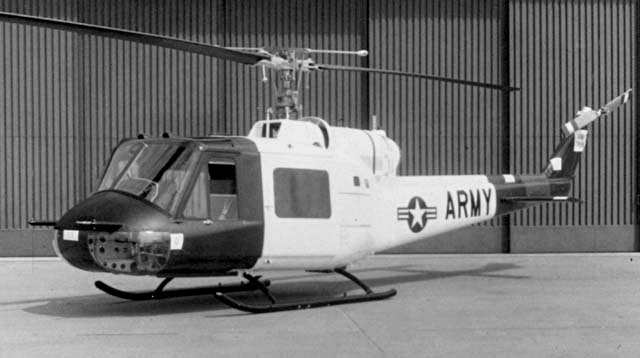| Picture |

|
| Manufacturer |
Bell
|
| Type |
204 B2 / UH-1 Iroquois / Huey
|
| Introduced |
11/1/1959
|
| In production? |
No
|
| Units produced |
2900
|
| Price US $ |
1,500,000.00
|
| Overall Length |
53 ft
|
| Length |
40.4 ft
|
| Height |
12.4 ft
|
| Width |
0 ft
|
| |
|
| |
|
| Description |
With the introduction of Model 204, Bell wrote helicopter history once again. It all started in 1952 with a demand from the US Army for a multipurpose, medium-lift utility helicopter. The military designation was HU-1, but the machine was soon given the nickname, Huey. In response, the air force changed the official designation to UH-1 Iroquois, albeit to no effect; everyone in the helicopter field still knows which machine the term 'Huey' refers to.
The UH-1 is a very successful model, mainly because of its extremely effective overall design. It initially used a turbine engine, which provides a lot more power without the excessive weight of a piston-powered machine. Second, it placed the turbine engine on the roof of the fuselage, meaning that the machine had a very spacious cabin. These two design decisions gave the Huey its versatility; it could be used for many different missions such as transportation, for medivac purposes, or even in an attack role. The Huey was also the first Western turbine-powered military helicopter.
The UH-1 uses the well-known Bell two-blade rotorhead with a stabilizer bar, like that already in use on the Model 47. It is this two-bladed system that gives the Huey its characteristic 'wop-wop' sound.
The Vietnam War was the first battlefield in which the Huey saw service (1959). Due to the huge numbers used, this helicopter also became known to the wider public. There were many versions of the UH-1 Iroquois developed. The 204-based models can be recognized by their shorter fuselage length compared to the more familiar Model UH-1H (and newer versions), with its longer fuselage. Bell calls this machine the Model 205.
Both the UH-1 and the UH-1H also have civilian versions that are marketed by Bell as Model 204 and Model 205, which appeared in that order.
|
| Advertisement |
|
| Design features |
- Main rotor blades built up of extruded aluminium spars and laminates
- All metal tail rotor blades
- Semi rigid rotorhead
- All metal semi-monocoque fuselage
- Engine mounted above fuselage aft of cabin
- Two fuel tanks on CG, immediately aft of cabin
|
With the introduction of Model 204, Bell wrote helicopter history once again. It all started in 1952 with a demand from the US Army for a multipurpose, medium-lift utility helicopter. The military designation was HU-1, but the machine was soon given the nickname, Huey. In response, the air force changed the official designation to UH-1 Iroquois, albeit to no effect; everyone in the helicopter field still knows which machine the term 'Huey' refers to.
The UH-1 is a very successful model, mainly because of its extremely effective overall design. It initially used a turbine engine, which provides a lot more power without the excessive weight of a piston-powered machine. Second, it placed the turbine engine on the roof of the fuselage, meaning that the machine had a very spacious cabin. These two design decisions gave the Huey its versatility; it could be used for many different missions such as transportation, for medivac purposes, or even in an attack role. The Huey was also the first Western turbine-powered military helicopter.
The UH-1 uses the well-known Bell two-blade rotorhead with a stabilizer bar, like that already in use on the Model 47. It is this two-bladed system that gives the Huey its characteristic 'wop-wop' sound.
The Vietnam War was the first battlefield in which the Huey saw service (1959). Due to the huge numbers used, this helicopter also became known to the wider public. There were many versions of the UH-1 Iroquois developed. The 204-based models can be recognized by their shorter fuselage length compared to the more familiar Model UH-1H (and newer versions), with its longer fuselage. Bell calls this machine the Model 205.
Both the UH-1 and the UH-1H also have civilian versions that are marketed by Bell as Model 204 and Model 205, which appeared in that order.
|
|
- Advertisement -
|
Design features:
- Main rotor blades built up of extruded aluminium spars and laminates
- All metal tail rotor blades
- Semi rigid rotorhead
- All metal semi-monocoque fuselage
- Engine mounted above fuselage aft of cabin
- Two fuel tanks on CG, immediately aft of cabin
|
| Persons |
10
|
| Max. Range |
230 mi
|
| Cruise Speed |
117 mph
|
| Max. Speed |
127 mph
|
| Max. rate of Climb |
1600 ft/min
|
| HOGE ceiling |
0 ft
|
| Service Ceiling |
18865 ft
|
| Gross Weight |
8501 lb
|
| Empty Weigt |
4800 lb
|
| Useful Load |
3701 lb
|
| Fuel Capacity |
242 gallons
|
| Number of Engines |
1
|
| Engine Type |
Turbine
|
| Engine Code |
Lycoming T53-13B
|
| Horse Power |
1400
|
| Rotorhead |
Teetering
|
| Number of rotorblades |
2
|
| Rotor Diameter |
48 ft
|
| Number of tail rotorblades |
2
|
| Tailrotor Diameter |
5.8 ft
|
|